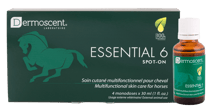
Skin & Coat Health in Horses
Healthy skin and a vibrant coat in horses are clinical indicators of systemic well-being. Dermatological conditions are commonly encountered in equine practice, and they often present as chronic, multifactorial disorders involving nutrition, environment, hypersensitivity reactions, and barrier dysfunction. Understanding the interplay between internal and external factors is critical to effective diagnosis and long-term management.
Clinical Importance of Skin Barrier Integrity
The equine epidermal barrier is a dynamic defense system, protecting against mechanical insults, pathogens, allergens, and water loss. Disruption of this barrier can lead to pruritus, secondary infections, and performance decline. In many cases, dermatologic signs are the first visible symptoms of deeper metabolic or immunological imbalances.
Veterinary care should therefore adopt a dual approach—addressing internal nutritional deficiencies and supporting skin restoration through targeted topical interventions.
Omega-3 Fatty Acids: Evidence-Based Support
Polyunsaturated omega-3 fatty acids—particularly eicosapentaenoic acid (EPA) and docosahexaenoic acid (DHA)—play an essential role in modulating inflammatory responses and maintaining skin homeostasis. Because horses cannot endogenously synthesize these fatty acids, supplementation becomes essential, especially in animals with limited access to fresh pasture or with elevated metabolic demands.
Key Veterinary Benefits of Omega-3 Supplementation:
- Anti-inflammatory modulation: EPA and DHA competitively inhibit arachidonic acid pathways, reducing the production of pro-inflammatory eicosanoids.
- Support for pruritic and allergic dermatoses: Particularly relevant in cases of insect bite hypersensitivity, atopic-like dermatitis, and chronic urticaria.
- Enhancement of skin hydration and follicular health: Promotes a glossy coat and supports the integrity of the stratum corneum.
- Immune regulation: Beneficial in horses exhibiting systemic hypersensitivities or recurrent dermatitis of unknown etiology.
Targeted supplementation with omega-3s should be considered in any dermatological management plan, particularly during periods of seasonal challenge or recovery from dermatoses.
Topical Interventions: Supporting the Epidermal Barrier Externally
Adjunctive topical therapy plays a vital role in restoring barrier function and alleviating clinical signs. Veterinary-formulated topical products containing essential fatty acids and plant-based bioactives can:
- Restore lipid lamellae: Reinforcing the intercellular matrix critical to moisture retention and microbial defense.
- Alleviate inflammation and pruritus: Through the inclusion of phytocompounds such as hemp, neem, and tea tree oils with documented anti-inflammatory and antimicrobial effects.
- Promote microbiome balance: Helping reduce dysbiosis and prevent secondary infections, particularly in lichenified or compromised skin.
Multimodal Management: A Synergistic Approach
In clinical practice, a combined strategy that integrates systemic nutrition and topical therapy often yields the best outcomes. This approach is particularly recommended for:
- Horses experiencing seasonal or recurrent dermatitis (e.g., IBH)
- Equines recovering from superficial pyoderma, dermatophilosis, or fungal infections
- Animals subjected to environmental extremes or inadequate forage quality
- Cases exhibiting chronic dull coat, alopecia, or scaling
Preventative care protocols should incorporate ongoing barrier support and nutritional monitoring—not just episodic intervention.
Recommended skin and coat products for horses
Equine dermatology requires a proactive, multimodal approach that combines evidence-based nutritional interventions with advanced topical care. By supporting skin health both systemically and locally, we can improve outcomes in horses suffering from dermatological conditions and contribute to overall patient wellbeing and performance.
Dermoscent Essential Spot-On
Dermoscent Essential Spot-On for horses is a topically applied formulation containing essential fatty acids and soothing botanical extracts, designed for weekly application to maintain hydration and reinforce skin barrier function.

Dr Baddaky Omega-3
Dr Baddaky Omega-3 is a high-purity, marine-sourced EPA and DHA in a

veterinary-specific formulation, supporting systemic health in equines.
Both products are well-tolerated and supported as part of integrative skin care protocols in horses.
